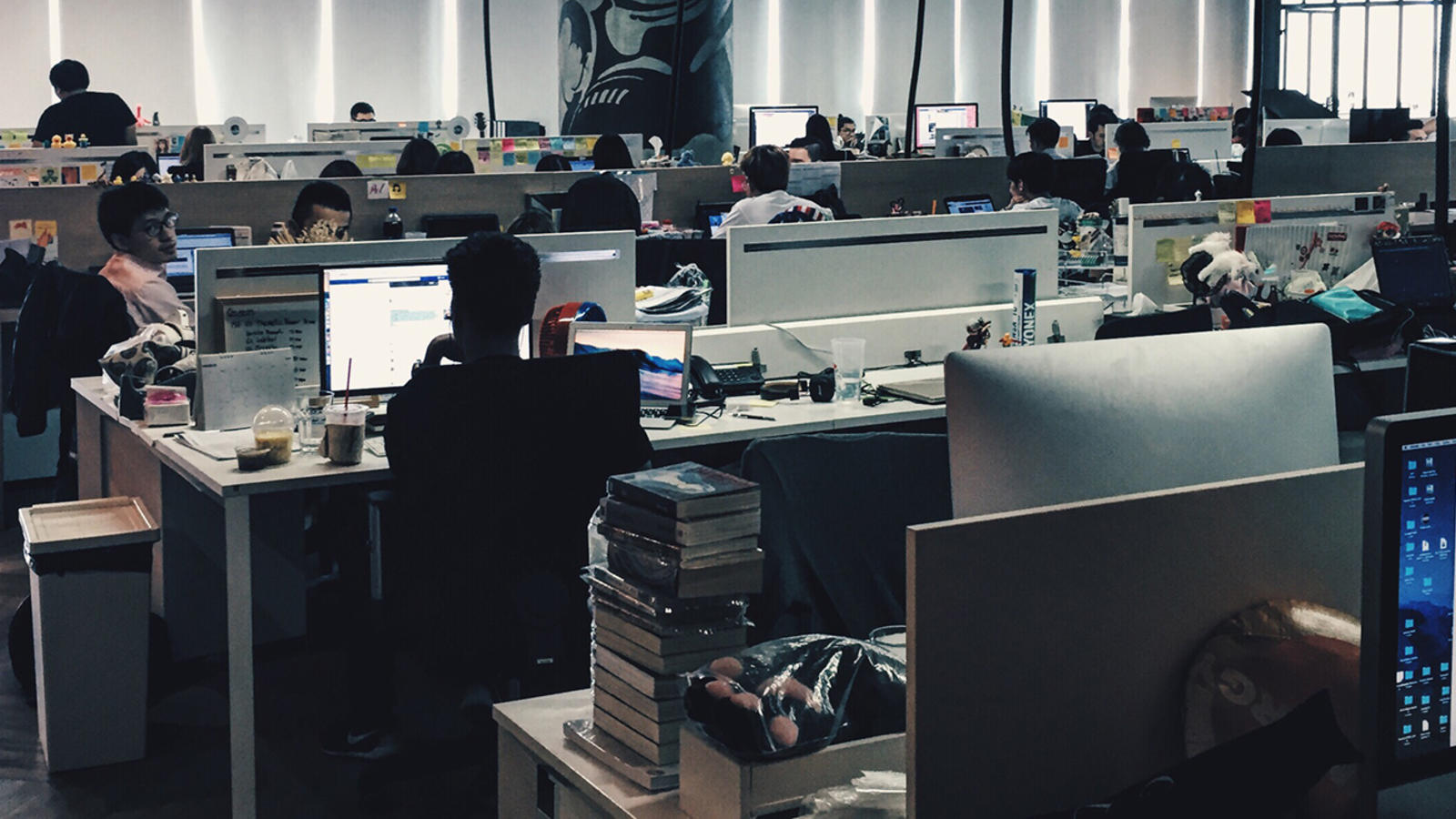
The Cure For The Common Cubicle
Can Science Help Us Build A Better Office Space?
By Jennifer Latson
Can Science Help Us Build A Better Office Space?
The shine wore off quickly for Apple’s $5 billion new office space. As one Silicon Valley publication reported, the sight of the massive open office plan induced expletive-laced ire in at least one manager, who requested that a satellite office be built for his team: one with walls and doors.
It’s been nearly two decades since the 1999 movie “Office Space” lampooned cubicle culture. Since then, open offices have come to replace the beleaguered cubicle warren as the dominant workplace model. But human beings don’t seem to have gotten much happier — or more productive.
In a chapter of this year’s “Design for Health,” Jeremy Myerson and Gail Ramster, both workplace design researchers at London’s Royal College of Art, point to a disturbing and puzzling trend: “a loss of productivity and a rise in incidences of stress, depression and burnout” — a surprising development, given advances in design and technology.
Open offices weren’t a simple antidote to the angst of cubicle life, as it turned out. Numerous studies have backed up the backlash. The BBC reported earlier this year that research demonstrated people working in open offices were 15 percent less productive than their cubicled counterparts (not to mention twice as likely to get sick). Along with the increased social connection — and corresponding collaboration — designers had hoped to foster, open office spaces brought new sources of irritation for workers: higher noise levels, an increase in distractions, and a loss of privacy that left many longing for the office partitions of old.
A 2013 study published in the Journal of Environmental Psychology, based on surveys of more than 42,000 workers in 303 office buildings, found that enclosed private offices rated highest and open office plans lowest for worker satisfaction. Open offices got the worst feedback when it came to “sound privacy.” (Uncontrollable background noise isn’t just a distraction, other studies have found: It raises epinephrine levels, a marker of stress, and leads to decreased motivation.)
But even the purported benefits of working in open offices — the potential for increased brainstorming and innovation that comes from encountering your co-workers literally everywhere you turn — didn’t register as an incentive in the 2013 study. Ratings for “ease of interaction” were the same for open and private offices. The study’s authors, Jungsoo Kim and Richard de Dear, both professors of architecture, design and planning at the University of Sydney in Australia, concluded, “Our results categorically contradict the industry-accepted wisdom that open-plan layout enhances communication between colleagues and improves occupants’ overall work environmental satisfaction.”
So what’s the solution? Should we make a U-turn back to the cubicles we once reviled, or is there another way forward that could boost productivity and make employees happier and more creative at work?
Jing Zhou, the Houston Endowment Professor of Management at Rice University’s Jones Graduate School of Business, says the answer needs to include a blend of both private and open spaces.
“The research finds this almost paradoxical combination of needs: the need to be stimulated and the need for incubation, to sit and think,” she explained. “Open offices give you opportunities to interact with people you don’t normally talk to on a daily basis, increasing the chance of hearing something new or unusual.”
That’s a good thing, but it needs to be tempered with alone time to process the new material, she stressed.
“Even if you have lots of new ideas, you still need to think them through carefully. So open workspaces need to still ensure that people can be alone when they need to be, to focus and concentrate.”
When it comes to choosing the ideal office design, decision-makers need to consider the data — not just anecdotes about which office styles seem to have fostered innovation at other companies.
“Most of the time, companies haven’t had a careful study to compare this new office space, whatever it may be, with alternative styles, to see whether it truly enhances creativity,” Zhou said.
And the office layout itself is just one factor in employee productivity and wellbeing; the design process could be equally important. Myerson and Ramster are proponents of “co-design,” which allows workers to collaborate with designers to build offices with their needs and preferences in mind. Workers benefit not only from the end product itself, the designers argue, but also from their participation in creating it. “A ‘sense of control’ emerges from the literature as an established driver of wellbeing and happiness at work,” they write.
Even more than control, employees crave choice, according to a 2016 survey by Gensler, the world’s largest architecture and design firm. They asked more than 4,000 workers in 11 different industries about the ideal work conditions, and found that there was no one simple answer: People want different conditions at different times.
Sometimes they wanted to collaborate in open spaces; other times they preferred solitude. And ideal working conditions didn’t just comprise physical office space. The most creative, productive employees had flexibility in scheduling, to work at the times that best suited them. They also had access to amenities like gyms and child care — and, perhaps most importantly, good coffee. Companies that provided a diversity of spaces, including meeting rooms, private work areas, places to socialize, outdoor space, and access to “specialty coffee,” tended to foster more engagement and higher levels of innovation.
The ideal workspace included a significant amount of time away from the office as well. Using metrics designed to gauge innovation, leadership and creativity, Gensler’s survey found that the most innovative employees spent only 74 percent of their workweek in the office, compared to “less innovative employees,” who spent 86 percent of their time at work. Top innovators were also twice as likely to use cafeterias, coffee shops, and outdoor spaces. And they reported having twice as much choice in when and where to work, compared to lesser innovators.
The future of officing lies in variety — and the freedom to choose the right space at the right time, according to David Burkus, a professor of leadership and innovation at Oral Roberts University and the author of “Under New Management.”
“The best offices have a palette of spaces,” Burkus said. “They might have an open area but also different sizes of conference rooms. They have these things that look like miniature cubicles that you can just duck into if you need to take a phone call or something.”
In his book, Burkus points to the Gerson Lehrman Group, a New York consulting firm, as a model of the new frontier in office design.
“The entire space is a collection of various furniture types with a large coffee shop in the center of the first floor,” he writes. “In addition to the café stools and living room couches and chairs in the atrium, the office furnishings range from open tables to library-style carrels, to conference rooms big enough for large groups or small enough for just one person seeking solace.”
No one has an assigned desk; employees use lockers to store their stuff for the day. And they’re allowed to work anywhere they want, although Burkus explains that the building is organized into “neighborhoods.” Based on the type of work they do, people tend to cluster near their co-workers.
Studies bear out the efficiency of this model, Burkus said.
“The level of autonomy that people have over their workspace does correlate pretty strongly with productivity and the level of work they do,” he said.
That’s not to say that there’s no data supporting the theory that open offices spark collaboration and serendipitous innovation; there is some, Burkus said, but not enough to outweigh the drawbacks of that model. And it would be disingenuous for companies to claim that they chose the model just for its propensity to spark startup-style innovation.
“If you think redesigning your office can make your company culture into that of a startup, you are sadly mistaken,” Burkus said. “The truth is that we have an open office trend because it was cheap. Startups popularized the trend, but they did it because they were bootstrapping. Then other companies suddenly got on board, and they sold it as a promotion of collaboration and innovation. But it’s really because there’s no cheaper model — you can fit a lot of bodies in an open office.”
Creating a variegated workspace like Gerson Lehrman’s, on the other hand, is expensive.
“They have space to seat 250 people, but they only have about 100 employees,” Burkus said. “You can’t just build the same number of seats as employees, because they need to roam around. That’s the downside of this: It’s not cheap.”
With cost as a hurdle, the palette model of workspace design may never be as ubiquitous as the open office. But that doesn’t mean companies can’t give their employees more autonomy, no matter what the office layout looks like.
Even if you don’t run the company, you can harness the productivity-boosting power of autonomy by simply giving your employees more choice in when and where they work.
“If you’re the CEO and have the power to create your office, great,” Burkus said. “But if you’re a middle manager and you don’t have that say, at the very least you can create that autonomy on your team by letting workers know that they’re free to roam — they can work from home or at the library across the street, say.”
Leaving the office doesn’t necessarily mean sacrificing the brainstorming benefits of face-to-face interactions, Zhou says. These can happen just as easily in the virtual realm, using a company’s IT platform or a messaging application such as Slack.
“It’s an informal way for people to share the problems they have and ways to address those problems,” she said. “It doesn’t have to be in a physical space; it’s still a way to share ideas and brainstorm. And you’re not constrained by who to invite to a brainstorming meeting or where to fit everyone. The whole company can be involved.”
The office of the future could be a mishmash of styles, or it could look identical to the office of today, but with an added layer of employee autonomy. What’s clear is that the open office is no longer trending — more likely than not, it will soon go the way of the cubicle.
“We’ve hit peak open office,” Burkus said. “We’re already on the way down.”
Jennifer Latson is an editor at Rice Business Wisdom and the author of The Boy Who Loved Too Much, a nonfiction book about a rare disorder called Williams syndrome.
Never Miss A Story


